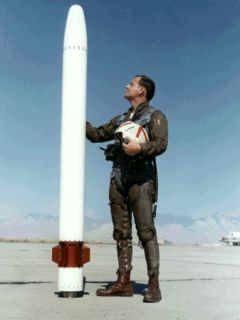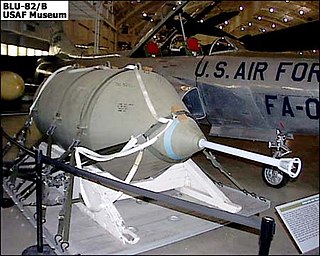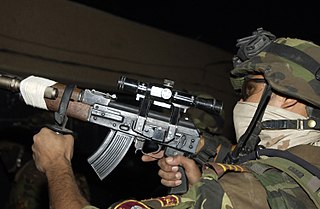 W
WThe AGM-65 Maverick is an air-to-ground missile (AGM) designed for close air support. It is the most widely produced precision-guided missile in the Western world, and is effective against a wide range of tactical targets, including armor, air defenses, ships, ground transportation and fuel storage facilities.
 W
WThe Boeing AGM-69 SRAM was a nuclear air-to-surface missile. It had a range of up to 50 nautical miles, and was intended to allow US Air Force strategic bombers to penetrate Soviet airspace by neutralizing surface-to-air missile defenses.
 W
WThe AIM-95 Agile was an air-to-air missile developed by the United States. It was developed by the US Navy to equip the F-14 Tomcat, replacing the AIM-9 Sidewinder. Around the same time, the US Air Force was designing the AIM-82 to equip their F-15 Eagle, and later dropped their efforts to join the Agile program. In the end, newer versions of Sidewinder would close the performance gap so much that the Agile program was cancelled.
 W
WThe AK-74 is an assault rifle developed in the early 1970s by Soviet weapons designer Mikhail Kalashnikov to replace the earlier AKM. It uses a smaller 5.45×39mm cartridge, replacing the 7.62×39mm chambering of earlier Kalashnikov-pattern weapons.
 W
WThe BGM-71 TOW is an American anti-tank missile. TOW replaced much smaller missiles like the SS.10 and ENTAC, offering roughly twice the effective range, a more powerful warhead, and a greatly improved semi-automatic guidance system that could also be equipped with infrared cameras for night time use.
 W
WThe BLU-82B/C-130 weapon system, known under program "Commando Vault" and nicknamed "Daisy Cutter" in Vietnam for its ability to flatten a section of forest into a helicopter landing zone, is an American 15,000-pound (6,800 kg) conventional bomb, delivered from either a C-130 or MC-130 transport aircraft or a CH-54 heavy-lift "SkyCrane" helicopter from the 1st Air Cavalry. A total of 225 were constructed. It was successfully used during military operations in Vietnam, the Gulf War and Afghanistan. The BLU-82 was retired in 2008 and replaced with the more powerful GBU-43/B MOAB.
 W
WThe Harpoon is an all-weather, over-the-horizon, anti-ship missile, developed and manufactured by McDonnell Douglas. The Standoff Land Attack Missile (SLAM) is a land-attack variant.
 W
WThe Spanish munitions company Instalaza made two models of rifle grenade during the 1960s. As well as being used by the Spanish Army, the Portuguese Army also used them in the colonial wars that took place in its colonies in Africa.
 W
WThe Leader T2 MK5 Series firearms were chambered for the 5.56×45mm NATO cartridge and manufactured by Leader Dynamics of Smithfield, NSW, Australia (1978-1982/1983). The Leader was the brainchild of weapons designer Charles St. George. It was originally a contender for a 5.56 mm Australian military service rifle to replace the then-issued Lithgow L1A1-F1 SLR and Colt M16A1 rifles. What was unique about this endeavor was that Australia had never designed or manufactured its own commercial gas-operated semi-automatic rifle. The rifle was abandoned when the Steyr AUG was adopted for use by the Australian military.
 W
WYugoslavia manufactured two types of rifle grenade, both with the nomenclature of M60. The M60 anti-personnel rifle grenade bore a resemblance to the French M52 rifle grenade. The M60 anti-tank rifle grenade bore a resemblance to the STRIM 65, also of French origin. It could penetrate 200mm of armour.
 W
WThe MGM-52 Lance is a mobile field artillery tactical surface-to-surface missile system used to provide both nuclear and conventional fire support to the United States Army. The missile's warhead was developed at Lawrence Livermore National Laboratory. It was replaced by MGM-140 ATACMS, which was initially intended to likewise have a nuclear capability during the Cold War.
 W
WRIM-7 Sea Sparrow is a U.S. ship-borne short-range anti-aircraft and anti-missile weapon system, primarily intended for defense against anti-ship missiles. The system was developed in the early 1960s from the AIM-7 Sparrow air-to-air missile as a lightweight "point-defense" weapon that could be retrofitted to existing ships as quickly as possible, often in place of existing gun-based anti-aircraft weapons. In this incarnation it was a very simple system, guided by a manually aimed radar illuminator.
 W
WThe S-300 is a series of initially Soviet and later Russian long range surface-to-air missile systems produced by NPO Almaz, based on the initial S-300P version. The S-300 system was developed to defend against aircraft and cruise missiles for the Soviet Air Defence Forces. Subsequent variations were developed to intercept ballistic missiles. The S-300 system was first deployed by the Soviet Union in 1979, designed for the air defence of large industrial and administrative facilities, military bases and control of airspace against enemy strike aircraft. The system is fully automated, though manual observation and operation are also possible. Components may be near the central command post, or as distant as 40 km. Each radar provides target designation for the central command post. The command post compares the data received from the targeting radars up to 80 km apart, filtering false targets, a difficult task at such great distances. The central command post features both active and passive target detection modes.
 W
WThe Sanna-77 is the end of a line of submachine guns which can trace their existence and lineage to the days of Rhodesia and their Unilateral Declaration of Independence in 1965.
 W
WThe STRIM 40 is an anti-personnel rifle grenade of French design and manufacture.
 W
WThe STRIM 65 is an anti-tank rifle grenade that the French Army used from 1961 to 1978, under the designation 65 AC 28. This and the older 73mm Modèle 1950 were the standard anti-tank munitions in French service. A 22 mm grenade launching adapter mounted atop the rifle's barrel held the grenade until the firing of a ballistite (blank) cartridge provided the propulsive force to launch the grenade.
 W
WThe Tabuk Sniper Rifle is an Iraqi Semi-automatic designated marksman's rifle, made from a modified version of the Zastava M70 assault rifle, itself a variant of the AKM. The Tabuk Rifle, like all the AKM and Dragunov SVD derivatives made in Iraq, was manufactured at the Al-Qadissiya Establishments using machinery sold to Iraq by Zastava Arms of Yugoslavia, when Saddam Hussein was president.
 W
WThe Vektor SS-77 is a general-purpose machine gun designed and manufactured by Denel Land Systems—formerly Lyttleton Engineering Works (LIW)—of South Africa.